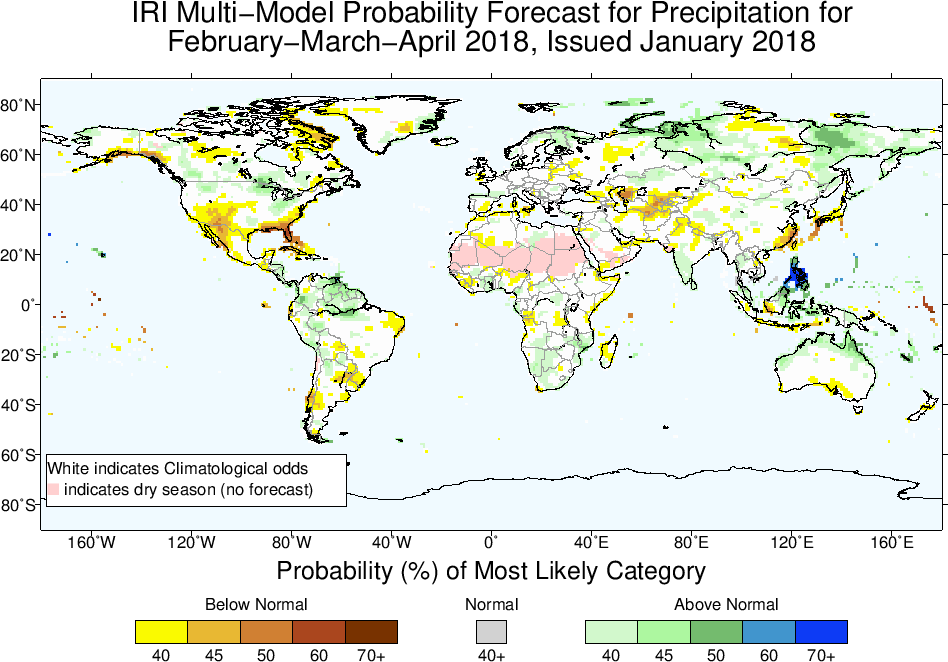January Climate Briefing: La Niña, She Persists
Read our ENSO Essentials & Impacts pages for more about El Niño and La Niña.
Tony Barnston provides an overview of the briefing
What’s New
Since last month’s briefing, sea-surface temperature (SST) anomalies have remained steady in the area of the central equatorial Pacific Ocean that helps define El Niño and La Niña events, called the Nino3.4 region (see first map below). The average of these weekly anomalies for the last month is around -0.7ºC, which falls in the category of a weak La Niña state.
Outgoing longwave radiation, which serves as a proxy measurement of thunderstorm activity, shows a signature La Niña pattern of reduced rainfall in the equatorial zone around 180º longitude (see second figure below). This pattern indicates that La Niña is likely to continue to have an influence on weather patterns around the world, in the near-term. The recent precipitation anomalies, shown in the third figure below, show some manifestation of identified La Niña teleconnections, while some typical climate impacts have been absent.
Sub-surface ocean temperatures, however, have significantly warmed in the last few weeks (see fourth figure below). These sub-surface conditions are often a preview of what’s to come at the surface, so it’s likely that La Niña conditions at the surface will diminish in the next couple of months.
But because IRI and the National Oceanic and Atmospheric Administration’s Climate Prediction Center predict that La Niña will continue for now, the ENSO alert level remains at a La Niña Advisory, which was initially issued in November.



ENSO Forecasts
From the Earth Institute: How Will La Niña Affect Winter in the U.S.?
To predict ENSO conditions, computers model the SSTs in the Nino3.4 region over the next several months. The plume graph below shows the outputs of these models, some of which use equations based on our physical understanding of the system (called dynamical models), and some of which use statistics, based on the long record of historical observations.
The average of the SST anomalies predicted by the models in this month’s forecast are similar to the predictions in last month’s forecast. Both dynamical and statistical models indicate a gradual warming over the forecast period, with both crossing into neutral ENSO territory by the March-May season. The dynamical models warm at higher rate, with conditions by next summer topping the +0.5ºC anomaly threshold. The statistical models’ mean anomaly reaches to about +0.25ºC by late summer, a bit warmer than last month’s forecast predicted. This period at the end of the forecast, however, is past the spring predictability barrier and is highly uncertain.

Based on the model outputs, La Niña conditions are likely to continue in the near term, with odds at 70% for the current January-March season. By the March-May season, neutral conditions are 70% likely, with a 30% of La Niña conditions and nearly no chance for El Niño. By the September to November season, El Niño chances become the most likely, but, again, uncertainty is high.
ENSO in context: Resource page on climate variability
The official probabilistic forecast issued by CPC and IRI in early January indicates similar overall trends in ENSO probabilities, but with less likelihood of El Niño in the later months. This early-January forecast uses human judgement in addition to model output, while the mid-month forecast relies solely on model output. More on the difference between these forecasts in this IRI Medium post.
IRI’s Global Seasonal Forecasts
Each month, IRI issues seasonal climate forecasts for the entire globe. These forecasts take into account the latest model outputs and indicate which areas are more likely to see above- or below-normal temperatures and precipitation.

For the upcoming February – April season, odds are moderately to strongly tipped in favor of above-normal rainfall in the Philippines and parts of Indonesia. Central-northern South America, parts of Russia, the U.S. Great Lakes region and northern Australia also show a tilt in the odds towards above normal precipitation. Drier than normal conditions are more likely in southern Alaska, the southern United States and western Mexico, as well as parts of South America and central and eastern Asia.
All forecast maps, including temperature in addition to precipitation, and including methodologies, are available on our seasonal forecast page.
Learn more about El Niño and La Niña on our ENSO resources page, and sign up here to get notified when the next forecast is issued. In the meantime, check out #IRIforecast.



You must be logged in to post a comment.